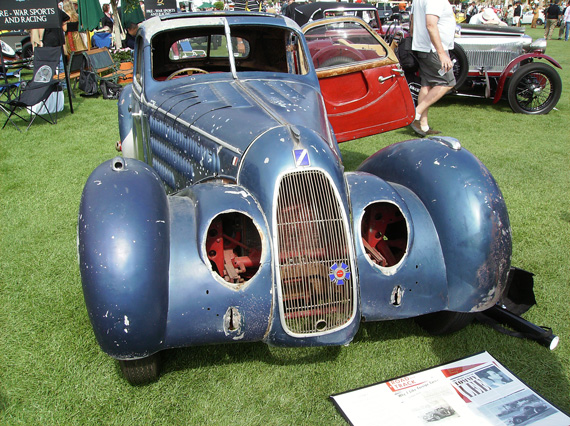
An unrestored classic among the finest restored classics on one of the world’s most prestigious golf courses. Elitch photo
Story by Brandes Elitch
Back in 2008 at the Quail Lodge, what I was looking for was a truly unique car, that neither I, nor anyone else, had seen before, at least not in my lifetime, a car that would blow you away when you saw it. I found what I wanted, and here is the story:
Don Lee started selling Cadillacs in 1906, and was awarded the West Coast distribution in 1919. In 1926, Lee bought KFRC radio in San Francisco, and the next year bought KHJ in Los Angeles. In 1929 he paid for LA’s first television broadcast, and in 1932 broadcast the first motion picture. Eventually, Lee owned twelve stations and became a CBS, and later, Mutual Broadcasting affiliate. To this day the ridge above the famous Hollywood sign, where he put his transmitter, is called Mount Lee. But in 1934, Lee succumbed to a heart attack, at only 54 years of age. His son, Thomas (Tommy) Lee inherited the empire, but left business management to CEO Willet Brown, to pursue, as author Lou Brooks has succinctly put it, “…his other interests, namely race cars and women.”
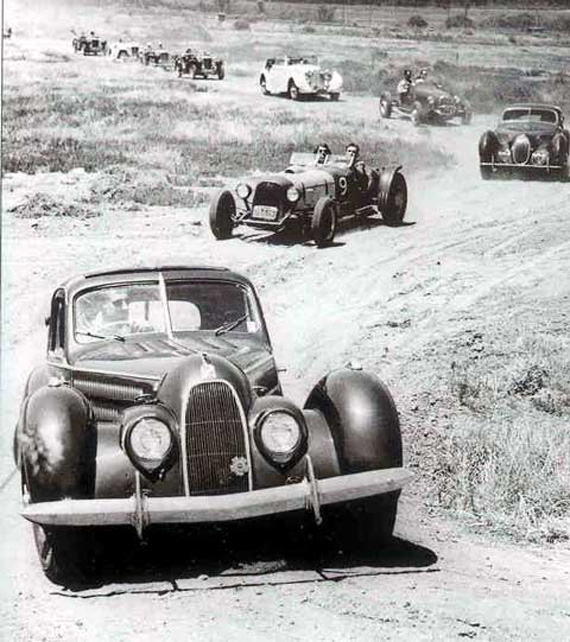
Roger Barlow races Stinky at Goleta in 1949. Photo by Jack Cambell, courtesy of Malcom Cambell Archives.
Tommy was only 28 when he inherited this empire. He collected cars from all over the world, sponsored race cars, and raced himself. Among the cars that interested him was the Talbot-Lago. Antonio (Anthony) Lago was the genius and inspiration that brought these special cars into the world. In 1934, when the British company Sunbeam Talbot Darracq fell into financial difficulty, the Rootes brothers took over the British operations, and Lago took over the French side. He had some definite ideas about how to make a grande routiere out of the Talbot; a new pushrod OHV hemi-head motor, the Wilson preselector gearbox, and a new IFS transverse spring layout. He asked Figoni et Falaschi to design and build the bodies. The car was a sensation. The first teardrop coupe was shown in 1937.
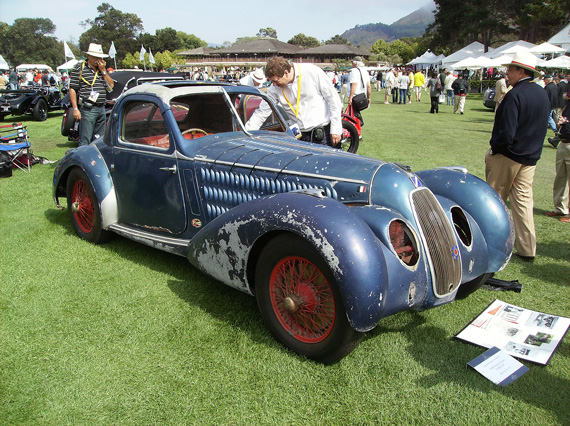
This Talbot Lago coupe was once owned by millionaire Tommy Lee, who reportedly owned four of the fourteen teardrop Talbots made. Elitch photo
The young Californian loved his Talbot Lago T-150C SS. He raced it on the street, and he raced it on the dry lakes such as Muroc, in stock form and against the hot rods, which must have been quite a sight. When Tommy owned it, he called it “Stinky”, probably after finding a dead rodent in the car, the hard way.
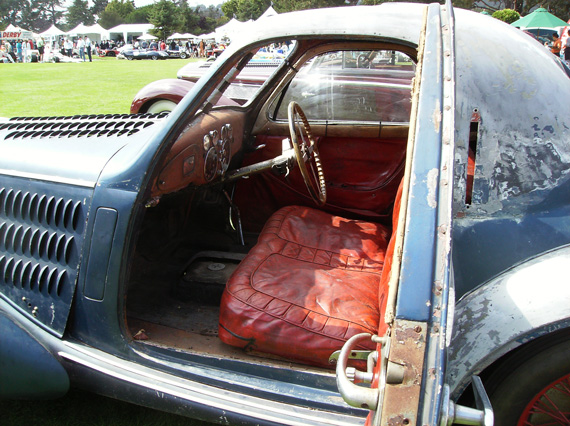
Interior seems to have weathered California’s heat in reasonably good condition. Note the coupe body style, different than the fastback style of the fourteen teardrop Talbots. Elitch photo
This car was one of two with this type of coupe body style. Its sister car had an entirely different, more conservative front end and was driven by Rosier/Huguet in the 1938 Le Mans, run as #6 and entered by Luigi Chinetti. The coupes were also called “Faux Cabriolets”. These two coupes were in addition to the fourteen (teardrop) fastback cars bodied by Figoni et Falaschi. Tommy Lee owned four of the Figoni et Falaschi bodied Talbots.
With good looks and unlimited wealth, Tommy lived a life that today’s car collector can only fantasize about (I’m talking about the cars here). On Friday, January 13, 1950 he flew from Palm Springs to LA for an appointment with his dentist at the Pellissier Building. He left the dentist’s office, and, while his chauffeur and nurse waited in the car, took the elevator up one floor, climbed out the window to the fire escape, and jumped to his death, at age 44. No one knows why.
Roger Barlow*, who owned International Motors in L.A., bought the Lee Talbot in 1948, still called “Stinky” and raced it at the Goleta time trials in 1949. But the coupe then disappeared around 1951, to be disassembled and left in a barn for a generation.
Left, a photo from Road & Track shows Barlow with “Stinky”.
This is a significant car, and for the last 50 years it was presumed lost. But it was just hiding, in a barn somewhere in Central California. And then, for The Quail, the owner had it disinterred and re-assembled in pieces on the show field, so people could see what an original, 70 year old unrestored car looks like.
Many people believe that the Figoni et Falaschi Talbots are among the very most beautiful cars ever built, which is why the mis en scene was so dramatic: one of the most desirable cars in the world looking like it was just dragged out of a junkyard, and dropped in the middle of the manicured greens of Quail Lodge! And so our vote for the Quail’s Most Interesting Car.
_____________________________________________________________
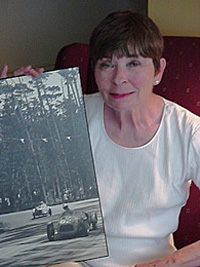 *In 2003 interview, Mary Barlow, pert and beautiful at sixty four, kept the memory of her late husband Roger alive and well. Roger, who died in 1990, created and raced the Barlow Simcas, with a great deal of success, particularly in 1952. The Barlow Simcas were made with a high degree of quality, and made such an impression that 50 years later the name Barlow Simca evokes instant recognition among car enthusiasts. In 1952, Roger received a cup from the Simca company, honoring him for his string of victories in a Simca-based racecar.
*In 2003 interview, Mary Barlow, pert and beautiful at sixty four, kept the memory of her late husband Roger alive and well. Roger, who died in 1990, created and raced the Barlow Simcas, with a great deal of success, particularly in 1952. The Barlow Simcas were made with a high degree of quality, and made such an impression that 50 years later the name Barlow Simca evokes instant recognition among car enthusiasts. In 1952, Roger received a cup from the Simca company, honoring him for his string of victories in a Simca-based racecar.
Barlow was born Roger Kleinschmidt in 1912. His family changed their name during the anti-German nonsense in World War I. After two stints in the US Navy, where he learned photography, he made his way to California. He established a Simca dealership and constructed the famous race cars in his shop. Later, he turned to cinematography, gaining credits on three movies and many documentaries. A race car driver, constructor, hunter, writer, photographer and life-long car nut, Roger Barlow was one of those larger than life characters who will never be forgotten.[Editor]
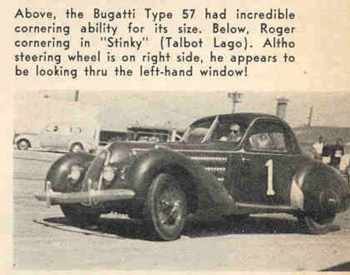
If that car were on the road today with a body like that, it would turn more heads than any of today’s Ferraris or the Kardashian girls!
I remember one time when I was visiting New York City in the early ’60s, I saw one of the teardrop Talbo-Lago coupes on the street, and nearly had a heart attack. What a magnificently beautiful automobile!
We owned a red tear drop Talbot Lago T150C SS coupe, which we acquired from Otto Zipper who, every year, alternated as “owner” with Briggs Cunningham …. why, I have no idea!
We found it to be hot, noisy, smelly, and claustrophic, and were happy to virtually give it away to film director, John Calley.
Later on, we traded our open Dubos two seater Talbot Lago for a down-at-heel and incomplete Talbot Lago 26c GP car.
One thing is for sure, we were not (then and now) motivated by the possibility of appreciation and financial gain …. oh well!